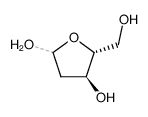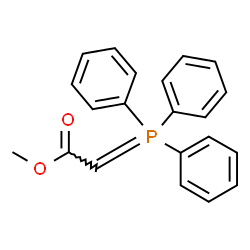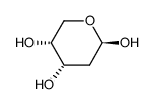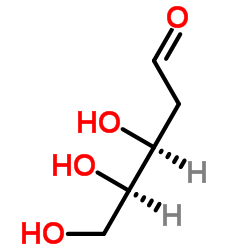78606-80-1
| 中文名 | BML-111,脂蛋白A4激动剂 |
|---|---|
| 英文名 | Methyl (5S,6R)-5,6,7-trihydroxyheptanoate |
| 英文别名 |
(5S,6R)-methyl 5,6,7-trihydroxyheptanoate
Methyl (5S,6R)-5,6,7-trihydroxyheptanoate (5S,6R)-6-hydroxy-5-methyl-2-heptanone |
| 描述 | BML-111 一种脂蛋白 A4 类似物,是一种脂蛋白 A4 (lipoxin A4) 受体激动剂。BML-111 可抑制血管紧张素转化酶 (ACE) 的活性,并增加血管紧张素转化酶 2 (ACE2) 的活性。BML-111 具有抗血管生成,抗肿瘤和抗炎的特性。 |
|---|---|
| 相关类别 | |
| 靶点 |
Lipoxin A4 receptor[1] Angiotensin converting enzyme (ACE)[2] |
| 体外研究 | 在H22细胞中,BML-111抑制血管内皮生长因子的产生并降低缺氧诱导因子-1α水平[1]。BML-111以5nm的IC50抑制白三烯B4诱导的细胞迁移[3]。 |
| 体内研究 | 小鼠体内注射肿瘤相关血管生成(111-15天);肿瘤抑制区域(1-15天)。BML-111还促进原位凋亡,同时抑制巨噬细胞在肿瘤组织中的浸润[1]。BML-111对LPS诱导的急性肺损伤和LPS/D-GalN诱导的急性肝损伤具有保护作用。BML-111抑制ACE活性,但增加ACE2活性。BML-111降低ACE、AngII和AngII-1型受体(AT1R)的表达水平,同时增加ACE2、血管紧张素-(1-7)(Ang-1-7)和Mas的水平[2]。动物模型:雄性印迹对照区小鼠(5-6周龄,18-22g)注射H22细胞[1]剂量:1mg/kg给药:腹腔注射,接种H22细胞前5min,接种后4h注射,每12h注射一次,连续2天,结果:抑制了肿瘤相关血管生成和肿瘤生长。 |
| 参考文献 |
| 密度 | 1.2±0.1 g/cm3 |
|---|---|
| 沸点 | 360.8±42.0 °C at 760 mmHg |
| 分子式 | C8H16O5 |
| 分子量 | 192.210 |
| 闪点 | 143.5±21.4 °C |
| 精确质量 | 192.099777 |
| PSA | 86.99000 |
| LogP | -1.72 |
| 蒸汽压 | 0.0±1.8 mmHg at 25°C |
| 折射率 | 1.489 |
| 储存条件 | -20°C, 干燥 |
|
Section1. IDENTIFICATION OF THE SUBSTANCE/MIXTURE Product identifiers Product name: 5(S),6(R),7-Trihydroxyheptanoic acid methyl ester CAS-No.: 78606-80-1 Relevant identified uses of the substance or mixture and uses advised against Identified uses: Laboratory chemicals, Manufacture of substances Section2. HAZARDS IDENTIFICATION Classification of the substance or mixture Not a hazardous substance or mixture according to Regulation (EC) No. 1272/2008. This substance is not classified as dangerous according to Directive 67/548/EEC. Label elements The product does not need to be labelled in accordance with EC directives or respective national laws. Other hazards - none Section3. COMPOSITION/INFORMATION ON INGREDIENTS Substances Synonyms: BML 111 Formula: C8H16O5 Molecular Weight: 192,21 g/mol Section4. FIRST AID MEASURES Description of first aid measures If inhaled If breathed in, move person into fresh air. If not breathing, give artificial respiration. In case of skin contact Wash off with soap and plenty of water. In case of eye contact Flush eyes with water as a precaution. If swallowed Never give anything by mouth to an unconscious person. Rinse mouth with water. Most important symptoms and effects, both acute and delayed To the best of our knowledge, the chemical, physical, and toxicological properties have not been thoroughly investigated. Indication of any immediate medical attention and special treatment needed no data available Section5. FIREFIGHTING MEASURES Extinguishing media Suitable extinguishing media Use water spray, alcohol-resistant foam, dry chemical or carbon dioxide. Special hazards arising from the substance or mixture Carbon oxides Advice for firefighters Wear self contained breathing apparatus for fire fighting if necessary. Further information no data available Section6. ACCIDENTAL RELEASE MEASURES Personal precautions, protective equipment and emergency procedures Avoid dust formation. Avoid breathing vapors, mist or gas. Environmental precautions Do not let product enter drains. Methods and materials for containment and cleaning up Sweep up and shovel. Keep in suitable, closed containers for disposal. Reference to other sections For disposal see section 13. Section7. HANDLING AND STORAGE Precautions for safe handling Provide appropriate exhaust ventilation at places where dust is formed. Conditions for safe storage, including any incompatibilities Store in cool place. Keep container tightly closed in a dry and well-ventilated place. Recommended storage temperature: -20 °C Specific end uses no data available Section8. EXPOSURE CONTROLS/PERSONAL PROTECTION Control parameters Components with workplace control parameters Exposure controls Appropriate engineering controls General industrial hygiene practice. Personal protective equipment Eye/face protection Use equipment for eye protection tested and approved under appropriate government standards such as NIOSH (US) or EN 166(EU). Skin protection Handle with gloves. Gloves must be inspected prior to use. Use proper glove removal technique (without touching glove's outer surface) to avoid skin contact with this product. Dispose of contaminated gloves after use in accordance with applicable laws and good laboratory practices. Wash and dry hands. The selected protective gloves have to satisfy the specifications of EU Directive 89/686/EEC and the standard EN 374 derived from it. Body Protection Choose body protection in relation to its type, to the concentration and amount of dangerous substances, and to the specific work-place., The type of protective equipment must be selected according to the concentration and amount of the dangerous substance at the specific workplace. Respiratory protection Respiratory protection is not required. Where protection from nuisance levels of dusts are desired, use type N95 (US) or type P1 (EN 143) dust masks. Use respirators and components tested and approved under appropriate government standards such as NIOSH (US) or CEN (EU). Section9. PHYSICAL AND CHEMICAL PROPERTIES Information on basic physical and chemical properties a) AppearanceForm: solid b) Odourno data available c) Odour Thresholdno data available d) pHno data available e) Melting point/freezingno data available point f) Initial boiling point and no data available boiling range g) Flash pointno data available h) Evaporation rateno data available i) Flammability (solid, gas) no data available j) Upper/lowerno data available flammability or explosive limits k) Vapour pressureno data available l) Vapour densityno data available m) Relative densityno data available n) Water solubilityno data available o) Partition coefficient: n- log Pow: -0,991 octanol/water p) Autoignitionno data available temperature q) Decompositionno data available temperature r) Viscosityno data available s) Explosive propertiesno data available t) Oxidizing propertiesno data available Other safety information no data available Section10. STABILITY AND REACTIVITY Reactivity no data available Chemical stability no data available Possibility of hazardous reactions no data available Conditions to avoid no data available Incompatible materials Strong oxidizing agents Hazardous decomposition products Other decomposition products - no data available Section11. TOXICOLOGICAL INFORMATION Information on toxicological effects Acute toxicity no data available Skin corrosion/irritation no data available Serious eye damage/eye irritation no data available Respiratory or skin sensitization no data available Germ cell mutagenicity no data available Carcinogenicity IARC:No component of this product present at levels greater than or equal to 0.1% is identified as probable, possible or confirmed human carcinogen by IARC. Reproductive toxicity no data available Specific target organ toxicity - single exposure no data available Specific target organ toxicity - repeated exposure no data available Aspiration hazard no data available Potential health effects InhalationMay be harmful if inhaled. May cause respiratory tract irritation. IngestionMay be harmful if swallowed. SkinMay be harmful if absorbed through skin. May cause skin irritation. EyesMay cause eye irritation. Signs and Symptoms of Exposure To the best of our knowledge, the chemical, physical, and toxicological properties have not been thoroughly investigated. Additional Information RTECS: Not available Section12. ECOLOGICAL INFORMATION Toxicity no data available Persistence and degradability no data available Bioaccumulative potential no data available Mobility in soil no data available Results of PBT and vPvB assessment no data available Other adverse effects no data available Section13. DISPOSAL CONSIDERATIONS Waste treatment methods Product Offer surplus and non-recyclable solutions to a licensed disposal company. Contaminated packaging Dispose of as unused product. Section14. TRANSPORT INFORMATION UN number ADR/RID: -IMDG: -IATA: - UN proper shipping name ADR/RID: Not dangerous goods IMDG: Not dangerous goods IATA:Not dangerous goods Transport hazard class(es) ADR/RID: -IMDG: -IATA: - Packaging group ADR/RID: -IMDG: -IATA: - Environmental hazards ADR/RID: noIMDG Marine pollutant: noIATA: no Special precautions for user no data available SECTION 15 - REGULATORY INFORMATION N/A SECTION 16 - ADDITIONAL INFORMATION N/A |
| 危险品运输编码 | NONH for all modes of transport |
|---|
|
~96% 
78606-80-1 |
| 文献:Corey, E. J.; Marfat, Anthony; Munroe, John; Kim, Kwan Soo; Hopkins, Paul B.; Brion, Francis Tetrahedron Letters, 1981 , vol. 22, p. 1077 - 1080 |
|
~% 
78606-80-1 |
| 文献:Sasaki, Makoto; Ishikawa, Makoto; Fuwa, Haruhiko; Tachibana, Kazuo Tetrahedron, 2002 , vol. 58, # 10 p. 1889 - 1911 |
|
~% 
78606-80-1 |
| 文献:Petasis, Nicos A. Patent: US2005/203184 A1, 2005 ; Location in patent: Page/Page column 15 ; |
|
~% 
78606-80-1 |
| 文献:Sasaki, Makoto; Ishikawa, Makoto; Fuwa, Haruhiko; Tachibana, Kazuo Tetrahedron, 2002 , vol. 58, # 10 p. 1889 - 1911 |
|
~% 
78606-80-1 |
| 文献:Corey, E. J.; Marfat, Anthony; Munroe, John; Kim, Kwan Soo; Hopkins, Paul B.; Brion, Francis Tetrahedron Letters, 1981 , vol. 22, p. 1077 - 1080 |
| 上游产品 3 | |
|---|---|
| 下游产品 1 | |








![[5S,12R]-二羟基-[6Z,8E,10E,14Z]-二十碳四烯酸结构式](https://image.chemsrc.com/caspic/019/71160-24-2.png)